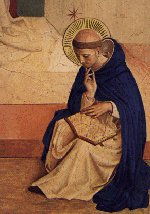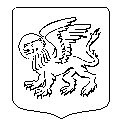
Saint Dominic
contemplating the Scriptures
Comments have been prepared by Chris Haslam using reputable commentaries, and checked for accuracy by the Venerable Alan T Perry. While not intended to be exhaustive, they are an aid to reading the Scriptures with greater understanding.
Comments are best read with the lessons.
Feedback to
is always
welcome.
 PDF file
PDF file
Ruth
This is a short story set in the period before 1000 BC, when warlords ruled Israel: they raised a militia in time of need, and stayed on to settle disputes in the community. It is a book about love and fidelity, of how Ruth, a Moabite widow in a Jewish family brings her widowed mother-in-law back to enjoying life. Near the end of the book, Ruth bears a son who becomes David's grandfather. This carries a message: marrying foreigners is acceptable. When it was written is uncertain, but this message gives us a clue: at various times, pagans were blamed for Israel's sorry state of morals. Pagans came to Israel through intermarriage, so marrying non-Israelites was, at least, opposed. This occurred twice: during the time of Josiah and Jeremiah (about 600 BC) and of Nehemiah (about 450 BC).
Ruth 1:1-18
This story is set “in the days when the judges ruled”. Before the institution of the monarchy, “judges”, wise people, arbitrated disputes, ruled the land, and raised a militia to defend it. Because of a “famine” in Judah, “Elimelech” (v. 2) and his family migrate to Moab, the high well-watered plateau to the east of the Dead Sea. (“Ephrathites” were people in the Bethlehem area.) Elimelech dies (v. 3).
The two sons marry local girls, but then die (v. 5), so now there are three widows. In this patriarchal culture, they are powerless, destitute. News reaches them that the famine is over (v. 6), so they set out to return to Judah (v. 7). But then Naomi suggests that they “go back ... to your mother’s house” (v. 8). (Note how often “go back” and “return” occur in our reading.) Usually a widow returned to her father’s house; perhaps the author emphasizes the absence of men in the women’s lives.
Naomi acknowledges the steadfast loyalty of the two young widows to her and her sons, and prays that God will stand by them in the future. May they marry again; may they find permanent “security”, (v. 9, true fulfilment), in the houses of their new husbands. She releases them from any sense of obligation to her sons. But they express their loyalty to her (v. 10).
At the time, Israelites practised levirate marriage: when a man died with no heir, his brother was obliged to marry the widow; a son born of this union was the heir to the dead man’s property. (Levir is Latin for brother-in-law.) But Naomi has no more sons to marry Orpah and Ruth. She is neither pregnant (v. 11) nor likely to remarry (v. 12). Even if a miracle occurs, would they wait for the sons to grow up? God is the source of her suffering (v. 13). (Their decision to stay with her has made, in her mind, “the Lord”, her Lord, theirs.) In departing, Orpah kisses, blesses, Naomi. But Ruth remains constant (v. 15): she is totally committed, for life, to accepting God as her god (vv. 16-17). V. 17b is part of a sworn oath: Ruth invites God’s wrath if she fails in her commitment to Naomi. The decision is made: Ruth will accompany Naomi to Judah. Naomi places the welfare of Orpah and Ruth above that of her sons. Sons born to a man’s widow, conceived through a kinsman, were considered his heirs; in this way, he continued to exist in Israel. By suggesting that Orpah and Ruth remain in Moab, she removes any chance of her menfolk’s immortality.
Psalms
Psalms is a collection of collections. The psalms were written over many centuries, stretching from the days of Solomon's temple (about 950 BC) to after the Exile (about 350 BC.) Psalms are of five types: hymns of praise, laments, thanksgiving psalms, royal psalms, and wisdom psalms. Within the book, there are five "books"; there is a doxology ("Blessed be ... Amen and Amen") at the end of each book.
Psalm 146
The psalmist will praise God throughout his life. We should not look to human leaders for security and help because they are finite: when they die, so do their “plans” (v. 4). (“Princes”, v. 3, are probably powerful and rich leaders rather than kings.) But God is to be trusted for he is creator, and maintains his pact with us forever; he is the guardian of moral order (vv. 5-6). He supports the disadvantaged: the hungry, the prisoner, the oppressed. (“Opens the eyes of the blind”, v. 8, per Isaiah 42:7, probably means frees captives.) He loves those who live in his ways (“the righteous”, v. 8) but works against the evil-doers. He cares for “strangers” (v. 9), aliens. He helps the exploited and status-less: “the orphan and the widow”. God rules eternally (unlike “princes”); he is Israel’s (“Jacob”, v. 5) in all ages.
Hebrews
Apart from the concluding verses (which may have been added later), this book is a treatise (or sermon) rather than a letter. Its name comes from its approach to Christianity: it is couched is Judaic terms. The identity of the author is unknown; Origen, c. 200 said that "only God knows" who wrote Hebrews. The book presents an elaborate analysis, arguing for the absolute supremacy and sufficiency of Christ as revealer and mediator of God's grace. Basing his argument on the Old Testament, the author argues for the superiority of Christ to the prophets, angels and Moses. Christ offers a superior priesthood, and his sacrifice is much more significant than that of Levite priests. Jesus is the "heavenly" High Priest, making the true sacrifice for the sins of the people, but he is also of the same flesh and blood as those he makes holy.
Hebrews 9:11-14
Vv. 1-7 tell of temple practice in ancient Israel. The forerunner of the Temple was a “tent” (v. 2), called the “Holy Place”. Within this “tent” was a second one, called the “Holy of Holies” (v. 3), where God dwelt. On the Day of Atonement (Yom Kippur), only the high priest went into “the second” tent (v. 7), to offer a sacrifice of animal blood for the redemption of unintentional sins. Annual repetition of this ritual shows that redemption from sin was of limited duration; that there were two tents shows that sacrifices could not remove the inner guilt (“perfect the conscience”, v. 9) of the faithful.
In somewhat like manner, when Christ came the first time, to redeem us of our sin, he passed through his risen body (the equivalent of the outer tent) into “the Holy Place” (v. 12, which must be the Holy of Holies, i.e. heaven). The blood in his saving act was his own (in crucifixion), not animal blood; therefore the redemption it achieved is forever. In the Temple, “ashes of a heifer” (v. 13) were mixed with water and used to purify the flesh, i.e. restore the ritual purity, of those who had touched the dead. If the high priest was able to achieve this, how much greater will be the effect of Jesus’ “blood” (v. 14), his sacrifice of his sinless self, in removing all traces of guilt for our past ungodly (“dead”) deeds enabling us to “worship the living God”. (His “eternal Spirit” is probably his spirit of self-offering.)

As witnesses to the events of Jesus life and death became old and died, the need arose for a written synopsis. Tradition has it that Mark, while in Rome, wrote down what Peter remembered. This book stresses the crucifixion and resurrection as keys to understanding who Jesus was. When other synoptic gospels were written, i.e. Matthew and Luke, they used the Gospel according to Mark as a source. Mark is most probably the John Mark mentioned in Acts 12:12: his mother's house was a meeting place for believers.
Mark 12:28-34
Some religious leaders have asked Jesus questions about issues central to Jewish thinking, trying to trap him:
He has avoided entrapment in both cases.
Now, in Mark, a scribe asks a question to learn rather than to entrap. There were 613 precepts in Jewish law. Which is the most important? Jesus offers two, not one; the first is the shema (“Hear, ...”, v. 29), recited twice daily by pious Jews. He links a second to the first: love your neighbour, whoever he is, as you do yourself (v. 31). Jesus combines these two precepts into a moral principle, linked by love. The scribe agrees and elaborates (vv. 32-33): there being only one God, we should love him undividedly, with all our faculties. Both precepts are “much more important” than temple-based religion. Jesus tells him that he is now almost ready for the coming kingdom of God.
© 1996-2022 Chris Haslam